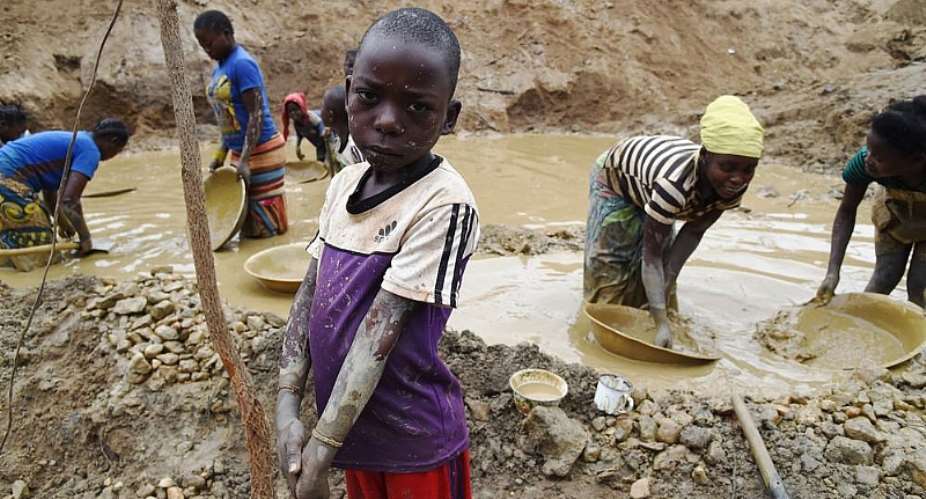Many children in Ghana are involved in work that is inimical to their health, education and development. According to the Ghana Statistical Services (GSS) 2014 Child Labour Report, almost 2 million children are estimated to be in child labour. This is a fifth of the population of children. Children do inappropriate work in many sectors of the economy: agriculture, manufacturing and services. In the area of mining, especially in Artisanal and Small-scale Gold Mining (ASGM), children are engaged in hazardous activities such as carrying of heavy loads of gold-bearing rocks, crashing and milling of gold ore, and amalgamation using mercury.
The inappropriate weight of heavy ore, inhalation of fine particles and exposure to poisonous chemicals and heavy duty machines jeopardises their health and safety. Moreover, this engagement usually prevents the children from acquiring the quality education they need as they grow into responsible adulthood. Correctly, child labour is a breach of the Constitutional guarantees provided for the protection of our children, and an affront to their fundamental human rights. Yet, the menace is present in all the regions of the country and affects both girls and boys of various ages.
To help tackle child labour in mining operations, the International Labour Organisation (ILO) is implementing the Caring Gold Mining Project, with support from the United States Department of Labour. The Project is working at the national level and in four local communities of the Ashanti and Western Regions. The overall strategy recognizes the need to bring together all those who matter in taking effective action to reduce child labour and improve working conditions in artisanal and small-scale gold mining (ASGM).
The Project has conducted community entry visits to Adumenu and Abedwum in the Adansi North Districts to have first-hand knowledge of the problems faced by miners and the reasons for which children are engaged in mining activities. Some of the causes of child labour are ignorance of the negative consequences of mining on children and the negligence of parents and guardians to protect their children from hazardous activities. A major reason is the desire for quick money at the expense of the long term gains of quality education.
There is need to ensure that mining policies do not just proscribe child labour in the general sense but also include specific measure to prevent children from getting into the sector. In this regard the Caring Gold Mining Project is working with the Ministry of Lands and Natural Resources, through the Minerals Commission to develop a child labour action plan in the context of the Multilateral Mining Integration Project (MMIP).
This has facilitated the establishment of a gender and child labour desk in the Minerals Commission, in order to provide a focused and consistent implementation of sustainable interventions against child labour. Other stakeholders are the Chamber of Mines and the Ghana National Association of Small-scale Miners (GNASSM). They would engage each other to enhance law enforcement and monitoring of the gold supply chain to ensure that children are not exploited in gold production process.





 'Kill whoever will rig Ejisu by-election' – Independent Candidate supporters inv...
'Kill whoever will rig Ejisu by-election' – Independent Candidate supporters inv...
 Ashanti Region: ‘Apologize to me for claiming I owe electricity bills else... – ...
Ashanti Region: ‘Apologize to me for claiming I owe electricity bills else... – ...
 Ghana is a mess; citizens will stand for their party even if they’re dying — Kof...
Ghana is a mess; citizens will stand for their party even if they’re dying — Kof...
 Internet shutdown an abuse of human rights — CSOs to gov't
Internet shutdown an abuse of human rights — CSOs to gov't
 Free SHS policy: Eating Tom Brown in the morning, afternoon, evening will be a t...
Free SHS policy: Eating Tom Brown in the morning, afternoon, evening will be a t...
 Dumsor: A British energy expert 'lied' Ghanaians, causing us to abandon energy p...
Dumsor: A British energy expert 'lied' Ghanaians, causing us to abandon energy p...
 What a speech! — Imani Africa boss reacts to Prof. Opoku Agyemang’s presentation
What a speech! — Imani Africa boss reacts to Prof. Opoku Agyemang’s presentation
 Dumsor: Tell us the truth — Atik Mohammed to ECG
Dumsor: Tell us the truth — Atik Mohammed to ECG
 Dumsor: Don't rush to demand timetable; the problem may be temporary — Atik Moha...
Dumsor: Don't rush to demand timetable; the problem may be temporary — Atik Moha...
 Space X Starlink’s satellite broadband approved in Ghana — NCA
Space X Starlink’s satellite broadband approved in Ghana — NCA
